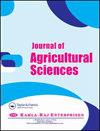Effects of Irrigation Programs Formed by Different Approaches on the Yield and Water Consumption of Black Cumin (Nigella sativa L.) under Transition Zone in the West Anatolia Conditions
IF 0.7
Q3 AGRICULTURE, MULTIDISCIPLINARY
引用次数: 8
Abstract
This study was carried out to determine the effects of different irrigation programs obtained by pan evaporation and water balance methods on some yield and vegetative parameters and water consumption of black cumin in the experiment field located in the center of Cobanlar District in Afyonkarahisar, Turkey during 2013 and 2014 growing seasons. In the experiment, the irrigation treatments were formed with 3 different irrigation intervals (SA3: 3 days, SA5: 5 days, and SA10: 10 days) and 4 different irrigation water levels as 0% (I0: non-irrigated) 50%, 75% (I50, I75: deficit irrigation) and 100% (I100: full irrigation) of the cumulative evaporation amount measured from class A pan in the first year and, of the required water amount to replenish the available soil moisture to the field capacity in the 0.60 m soil depth in the second year. The highest and the lowest evapotranspiration (ET) values were determined as 387.6 mm in SA3-I100 and as 166.9 mm in I0, respectively. The highest seed yield was obtained in SA5-I100 with an amount of 1700.6 kg ha-1 while the lowest seed yield was obtained in I0 with an amount of 722.2 kg ha-1. The highest total water use efficiency (WUE) and irrigation water use efficiency (IWUE) values were calculated from SA5-I50 as 5.11 kg ha-1 mm-1 and 4.80 kg ha-1 mm-1, respectively. While the yield response factor values (ky) were obtained as 0.75 (SA3), 0.80 (SA5) and 0.50 (SA10) for different irrigation interval, the mean ky value was determined as 0.68 according to all treatments of both years. Since the values of the yield and vegetative parameters and ET in same irrigation programs formed by two different methods were close to each other, the both methods can be used for irrigation of black cumin.不同灌溉方式对西部安纳托利亚过渡区黑小茴香产量和耗水量的影响
在土耳其Afyonkarahisar Cobanlar地区中部试验田,研究了2013年和2014年不同灌溉方案对黑孜然部分产量、营养参数和耗水量的影响。在试验中,形成3个不同灌溉间隔(SA3: 3 d、SA5: 5 d和SA10: 10 d)和4个不同灌溉水位(0% (I0:不灌溉)50%、75% (I50、I75:亏灌)和100% (I100: 100%)的灌溉处理。全灌量)为第一年A类锅测量的累积蒸发量,第二年0.60 m土壤深度将有效土壤水分补充到田间容量所需水量。SA3-I100蒸散量最大值为387.6 mm, I0蒸散量最小值为166.9 mm。SA5-I100的种子产量最高,用量为1700.6 kg ha-1; I0的种子产量最低,用量为722.2 kg ha-1。从SA5-I50计算得到的最高水分利用效率(WUE)和灌溉水分利用效率(IWUE)分别为5.11 kg ha-1 mm-1和4.80 kg ha-1 mm-1。不同灌溉间隔的产量响应系数(ky)分别为0.75 (SA3)、0.80 (SA5)和0.50 (SA10), 2年各处理的平均ky值为0.68。由于两种不同方法形成的相同灌溉方案的产量、营养参数和ET值接近,因此两种方法均可用于黑孜然灌溉。
本文章由计算机程序翻译,如有差异,请以英文原文为准。
求助全文
约1分钟内获得全文
求助全文
来源期刊

Journal of Agricultural Sciences
AGRICULTURE, MULTIDISCIPLINARY-
CiteScore
1.80
自引率
0.00%
发文量
0
 求助内容:
求助内容: 应助结果提醒方式:
应助结果提醒方式:


